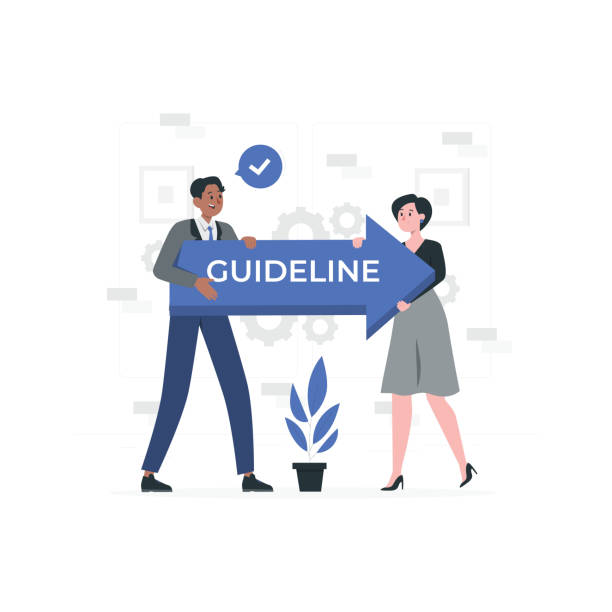Introduction to SEO-Optimized Website Design and Its Importance
In today’s digital world, having a website is not merely about having an online presence; rather, this presence must be discoverable by the target audience.
SEO, or Search Engine Optimization, is the main key to this discovery.
SEO-optimized website design means building a website that is designed and developed from the outset with Google’s and other search engines’ ranking factors in mind.
#This #educational #approach is very important because it helps your site appear higher in search results and attract more organic traffic.
Imagine you have a beautiful and user-friendly website, but no one can find it; this precisely illustrates the importance of SEO.
An SEO-optimized website design goes beyond keywords.
It includes technical aspects, content structure, user experience, and even site loading speed.
Many businesses start thinking about SEO after launching their website, whereas the correct approach is to consider SEO from the very first stages of design and development.
This proactive approach can reduce costs and accelerate results.
In this article, we will explain and guide you through all the important steps and aspects of this process so you can have a fully optimized website that is not only technically robust but also engaging and useful for users.
The ultimate goal of SEO-optimized website design is to achieve sustainable and high-quality organic traffic.
Organic traffic refers to visitors who arrive at your website through search results (without paying for advertisements).
This type of traffic usually has a higher conversion rate because users are looking for solutions or information that you provide.
A deep understanding of how search engines and their algorithms work is essential for anyone who intends to succeed in the online space.
This educational section helps you lay a proper foundation for your online presence and take the right path from the very beginning.
The importance of SEO-optimized website design cannot be overlooked.
In today’s competitive age, websites that appear on the first pages of search results capture the largest share of clicks and visitors.
If your website ranks on the second, third, or beyond pages, it will practically remain hidden from most users.
Therefore, investing in designing an SEO-optimized website is an investment in the future of your online business.
Next, we will delve into the technical and strategic details of this process.
Is your company’s website as professional and trustworthy as it should be? With specialized corporate website design by Rasawab, create an online presence that reflects your credibility and attracts more customers.
✅ Build a powerful and professional image for your brand
✅ Convert visitors into real customers
⚡ Get a free consultation now!
Technical SEO Principles in Website Structure
To achieve an SEO-optimized website design, technical principles are of high importance.
#These #technical #principles include factors that directly affect how your site is crawled and indexed by search engines.
The first step in this regard is having a logical and readable URL structure.
Short, descriptive URLs that include relevant keywords are beneficial for both users and search engines.
For example, instead of yoursite.com/page?id=123, use yoursite.com/services/website-design.
Site loading speed is an important ranking factor and directly impacts user experience.
Slow websites not only drive users away but are also penalized by search engines.
Image optimization, file compression (CSS, JavaScript), using browser caching, and choosing suitable hosting are among the essential measures to increase site speed.
A fast site is an integral part of a successful SEO-optimized website design.
This is a guidance and educational section that should be taken seriously.
Another vital technical aspect is the Robots.txt file and XML Sitemap.
Robots.txt tells search engines which parts of your site they can crawl and which they cannot.
This tool is useful for preventing low-value or duplicate pages from being indexed.
An XML Sitemap is a file containing a list of all important URLs on your site that helps search engines better understand your site’s structure and find new pages faster.
Ensuring the accuracy and up-to-dateness of these files is essential for SEO-optimized website design.
Implementing Structured Data (Schema Markup) can also help search engines better understand your content and display it in richer formats in search results (such as rating stars, product prices, event times).
This technical technique increases CTR (Click-Through Rate), even if your ranking doesn’t change.
Finally, having a site with a strong internal linking structure also helps search engines understand the hierarchy of your pages and distribute authority (Link Equity) across the entire site.
Keyword Research and Content Strategy
SEO-optimized website design is incomplete without comprehensive keyword research.
#Keywords #educational #are the bridge between what users search for and the content you provide.
To start, you need to compile a list of words and phrases that your target audience is likely to use to find the products, services, or information you offer.
This process involves identifying short-tail keywords with high search volume and long-tail keywords with lower search volume but more specific search intent.
Various tools are available for keyword research that can assist you in this process.
These tools show search volume, competition level, and related keywords.
The following table lists some of these important tools:
| Tool Name | Key Features | Type (Free/Paid) |
|---|---|---|
| Google Keyword Planner | Estimate search volume, new keyword ideas, linked to Google Ads | Free (with Google Ads account) |
| Ahrefs Keywords Explorer | In-depth keyword analysis, competitor analysis, vast database | Paid |
| Semrush Keyword Magic Tool | Find keywords, difficulty analysis, content topic ideas | Paid |
| Ubersuggest | Keyword suggestions, competitor analysis, content ideas | Free/Paid |
| Google Search Console | Keywords users found your site with | Free |
After keyword research, it’s time for content strategy.
Your content should not only include keywords but also be valuable, unique, and engaging for users.
This means producing content that answers users’ questions, solves their problems, and provides comprehensive and accurate information.
Specialized and analytical content, shaped by actual user needs, can significantly boost your ranking and contribute to an SEO-optimized website design.
Paying attention to Search Intent is crucial.
Is the user looking for information (Informational), intending to buy (Commercial/Transactional), or seeking a specific website (Navigational)? Your content must align with this intent.
For example, for an informational keyword, write a comprehensive article, and for a commercial keyword, provide a product or service page with complete details.
This smart approach is an important part of SEO-optimized website design.
On-Page SEO Techniques
On-Page SEO refers to a set of actions performed within your website to improve its ranking in search engine results.
#These #guidance #actions include optimizing various page elements for both search engines and users.
The first and most important elements are the Title Tag and Meta Description.
The title tag should include the main keyword of the page and be engaging and convincing to encourage users to click.
The meta description is also a short summary of the page’s content, which, although not a direct ranking factor, can increase the click-through rate (CTR).
Correct use of Heading tags (H1, H2, H3, etc.) in content structure is very important.
The H1 tag should be the main title of the page and contain the primary keyword.
H2 and H3 tags are used to divide content into subsections and improve readability, and they can include secondary keywords or synonyms.
This logical structure not only makes it easier for users to scan your content but also helps search engines understand the information hierarchy.
This is an explanatory and educational aspect in SEO-optimized website design.
Image optimization is also an important part of on-page SEO.
Images should be compressed to increase site loading speed, and Alt Text should be used to describe the image content.
Alt Text is not only useful for users with visual impairments but also helps search engines understand the image content and appear in image search results.
Using descriptive file names for images is also recommended.
These small but crucial details are highly effective in SEO-optimized website design.
Internal Linking is also a powerful on-page SEO strategy.
By linking related pages within your site to each other, you can “Link Equity” or SEO authority across the entire site and help search engines discover and index all your important pages.
Additionally, this helps users easily navigate your site and find more information, leading to increased dwell time and reduced bounce rate.
This is a technical approach that ultimately helps improve your overall site and achieve an SEO-optimized website design.
Did you know that 94% of users’ first impressions of a business are related to its website design? With professional corporate website design by **Rasawab**, turn this first impression into an opportunity for growth.
✅ Attract more customers and increase sales
✅ Build credibility and trust in the audience’s eyes⚡ Get a free website design consultation!
Off-Page SEO and the Importance of Backlinks
While on-page SEO focuses on optimizing elements within your website, off-page SEO refers to activities performed outside your website that influence your ranking.
#The most important #analytical #factor in off-page SEO is backlinks or inbound links from other sites.
Backlinks are considered a “vote of confidence” from other sites for your content.
The higher the number and quality of these backlinks, the greater your domain authority and power with search engines.
But not all backlinks are created equal.
Links coming from reputable, relevant, and high-domain authority websites are much more valuable than low-quality or spammy links.
Building a strong and natural backlink profile through specialized strategies such as creating valuable and shareable content, connecting with bloggers and influencers, and participating in online communities, is of high importance.
The goal is to attract backlinks that indicate your site is a credible and referenceable source, which itself stems from a good SEO-optimized website design.
In addition to backlinks, other off-page SEO activities include social media presence, unlinked brand mentions, and participation in relevant online forums.
Although these factors may not be direct ranking factors, they can lead to increased brand awareness, referral traffic, and ultimately, positive signals for search engines.
A successful off-page SEO campaign requires time, effort, and a strategic approach.
This analytical section helps you understand the depth of this topic.
The backlink building strategy should always focus on quality and relevance, not quantity.
Avoiding buying backlinks or participating in unnatural link-building schemes is essential, as these actions can lead to severe penalties from Google.
Google looks for signs of natural link building, indicating that your website is truly valuable and deserves high rankings.
This precision in choosing methods signifies a sustainable and SEO-optimized website design.
User Experience (UX) and Its Impact on SEO
In recent years, Google has increasingly emphasized the importance of User Experience (UX) as an SEO ranking factor.
#A poor #analytical #user experience can lead to a high Bounce Rate and low Dwell Time, which are negative signals for search engines.
An SEO-optimized website design should not only be optimized for search engines but also prioritize users.
This means designing a website with easy navigation, readable content, and attractive visual design.
One of the most important user experience metrics introduced by Google is Core Web Vitals.
These metrics include three main indicators: LCP (Largest Contentful Paint), which measures the loading speed of the largest content element; FID (First Input Delay), which measures the site’s responsiveness to the user’s first interaction; and CLS (Cumulative Layout Shift), which assesses the visual stability of pages (preventing sudden shifts of page elements during loading).
Improving these metrics directly helps improve your site’s SEO.
This is an explanatory and educational section for a deeper understanding of these concepts.
Responsive Design, which displays your website well on various devices (mobile, tablet, desktop), is also a crucial UX factor.
With the increasing use of mobile for searching, ensuring excellent performance of your site on mobile devices is essential.
Google uses a “Mobile-First Indexing” approach, meaning it prioritizes the mobile version of your site for indexing and ranking.
Therefore, an SEO-optimized website design is practically incomplete without responsive design.
Readable and engaging content, appropriate use of white space, suitable fonts, and logical page structure all contribute to a better user experience.
The more time users spend on your site and the less they become confused, the more positive signals are sent to Google.
This not only leads to higher rankings but also helps increase conversion rates and customer loyalty.
Therefore, always remember that in SEO-optimized website design, the user is always at the center of attention.
Mobile SEO and Mobile-First Indexing
Given the increasing number of internet users via mobile devices, the importance of mobile SEO has grown more than ever.
#Mobile SEO #news #means optimizing a website for excellent performance and display on smartphones and tablets.
Since 2018, Google has widely implemented the “Mobile-First Indexing” policy, meaning it considers the mobile version of your website as the primary version for indexing and ranking.
This means that if your site has a poor user experience on mobile, your ranking in search results will be severely impacted.
SEO-optimized website design today must be fully compatible with the mobile-first approach.
To ensure mobile optimization of the site, the following points should be considered:
| Factor | Explanation |
|---|---|
| Responsive Design | The website should automatically adjust its size and layout to the device’s screen size. |
| Mobile Loading Speed | Mobile pages must load very quickly. Using AMP and image compression is recommended. |
| Easy Clickability (Tap Targets) | Clickable elements (buttons, links) must be large enough and spaced appropriately to be easily tapped with a finger. |
| Readable Font | Font size on mobile devices should be large enough to be readable without zooming. |
| Avoid Intrusive Pop-ups | Pop-ups that cover the entire screen disrupt mobile user experience and may be penalized. |
Google Mobile-Friendly Test and Google PageSpeed Insights tools can help you evaluate your site’s mobile performance and identify potential issues.
These tools offer guidance and technical tips for improvement.
Ensuring that all your important content is also accessible and viewable on the mobile version is essential.
An SEO-optimized website designed for mobile not only achieves a better ranking but also provides a more enjoyable user experience for visitors.
This, in turn, leads to increased dwell time, reduced bounce rate, and ultimately, improved conversion rates.
This analytical and explanatory section shows that mobile SEO is no longer an option but a necessity.
Measuring SEO Success and Analytical Tools
After performing SEO-optimized website design and implementing SEO strategies, measuring and analyzing website performance is essential to understand the effectiveness of your efforts.
#This #educational #process helps you identify strengths and weaknesses and adjust your strategies based on real data.
One of the most important tools in this field is Google Analytics.
Google Analytics provides comprehensive and accurate information about your website traffic, including the number of visitors, pages visited, time spent on site, bounce rate, traffic sources (organic search, social media, referral, etc.), and user demographic information.
By analyzing this data, you can understand which pages are performing well, where users are coming from, and how they interact with your content.
This information is crucial for making informed decisions regarding continuous SEO improvement and SEO-optimized website design.
Another vital tool is Google Search Console.
This tool is provided directly by Google and offers information on how your site appears in search results.
You can see which keywords your site appears for in search results (Impressions), how many times users have clicked on it (Clicks), and your average ranking for each keyword.
Search Console also reports technical issues related to indexing, crawling errors, and security issues, which are very important for maintaining a healthy and SEO-optimized website design.
This technical section helps you gain a deeper insight into your SEO data.
In addition to Google’s tools, paid tools like Ahrefs and Semrush also offer advanced analytical capabilities, including competitor analysis, backlink profile examination, and keyword rank tracking.
Combining these tools provides a comprehensive view of your SEO performance and allows you to optimize your strategies for maximum effectiveness.
Continuous analysis and using these insights to refine strategies are the keys to long-term success in SEO.
This is an analytical and guidance section that helps your progress.
Are you dissatisfied with the low conversion rate of visitors to customers on your e-commerce site?
Solve this problem forever with professional e-commerce website design by Rasawab!
✅ Increase visitor-to-customer conversion rate
✅ Create an excellent user experience and build customer trust
⚡ Get a free consultation
Common Mistakes in SEO-Optimized Website Design and Ways to Avoid Them
On the path to SEO-optimized website design, you may encounter common mistakes that can render your efforts ineffective.
#Recognizing these mistakes #questionable content #and knowing how to avoid them is crucial.
One of the biggest mistakes is neglecting SEO from the very beginning of website design.
Many think SEO is an “add-on” that can be applied after the site is completed, whereas it should be considered from the planning and information architecture phase of the site.
Producing low-quality or duplicate content also is another major error.
Content that provides no real value to the user or is copied from other sites will not only fail to rank but can also be penalized by Google.
Always focus on producing original, valuable, and comprehensive content that answers user questions and addresses their needs.
Keyword Stuffing, which was common in the past, is now an outdated and harmful technique that damages SEO instead of improving it.
Neglecting User Experience (UX) in favor of SEO is also a grave mistake.
Although the ultimate goal is to attract traffic through SEO, if users have a bad experience after entering your site (slow speed, difficult navigation, unsuitable mobile design), they will quickly leave the site.
This leads to negative signals such as a high bounce rate, which damages your SEO ranking.
A good SEO-optimized website design simultaneously serves both search engines and users.
This guidance section helps you avoid these pitfalls.
Lack of proper internal linking, neglecting image optimization, and not regularly updating content are also among other common mistakes.
SEO is an ongoing process and requires monitoring and updating.
Neglecting these points can lead to a decline in your site’s ranking over time.
This analytical and explanatory section helps you pay closer attention to SEO details and answers your potential questions, ultimately contributing to building a more powerful SEO-optimized website design.
The Future of SEO and Continuous Optimization
The world of SEO is constantly changing and evolving.
What is effective today for SEO-optimized website design may not be enough tomorrow.
#Therefore, #news #continuous optimization and awareness of new trends are essential for maintaining rankings and long-term success.
Artificial Intelligence (AI) and Machine Learning are increasingly playing a role in Google’s algorithms, so Google focuses more than ever on understanding search intent, semantic relevance, and content quality.
One of the important trends is Voice Search.
With the widespread use of voice assistants like Google Assistant and Siri, optimizing for voice search queries, which are usually longer and more conversational, has become important.
This means that in your keyword strategy, you should pay attention to questions users might ask verbally.
This is a technical and analytical shift in how keywords are approached.
Interactive and video content will also play a more prominent role in future SEO.
Google aims to provide the best user experience, and more engaging and diverse content can increase user dwell time.
Optimizing videos for search engines (Video SEO) and adding subtitles and transcripts for them can help increase the visibility of your content.
This engaging and explanatory approach not only helps your ranking but also leads to attracting new audiences.
Ultimately, SEO is no longer just about “tricking” algorithms but about “serving” users.
Google constantly updates its algorithms to provide the best and most relevant results to users.
Therefore, focusing on producing high-quality content, improving user experience, and creating a strong technical website is the best strategy for the future.
SEO-optimized website design is not a one-time process but a long-term commitment to continuous improvement and evolution.
To succeed in the online space, you must always be learning and adapting to changes.
This is a news and guidance perspective that you should keep in mind.
Frequently Asked Questions
| Row | Question | Answer |
|---|---|---|
| 1 | What is an SEO-optimized website? | It is a website designed and developed following Search Engine Optimization (SEO) principles to achieve higher rankings in search results. |
| 2 | Why is having an SEO-optimized website important? | It increases visibility, attracts organic traffic, boosts conversions, and builds brand credibility, all of which contribute to business growth. |
| 3 | What are the key elements of SEO-optimized website design? | Technical SEO (speed, mobile compatibility), On-Page SEO (keywords, content), User Experience (UX), and website security (HTTPS). |
| 4 | How does website speed affect SEO? | Faster sites improve user experience, reduce bounce rates, and are favored by search engines, leading to better rankings. |
| 5 | Is mobile compatibility important for SEO? | Absolutely. Google uses mobile-first indexing, so responsive mobile design is crucial for ranking. |
| 6 | What role does content play in SEO-optimized website design? | High-quality, relevant, and keyword-optimized content is fundamental for attracting users and signaling relevance to search engines. |
| 7 | What is keyword research and why is it important? | Finding popular search terms people use. This process helps align content with user intent and attracts relevant traffic. |
| 8 | How is User Experience (UX) related to SEO? | Good UX (easy navigation, readability) keeps users on the site longer, reduces bounce rate, and sends positive signals to search engines. |
| 9 | What is a Sitemap and how does it help SEO? | It’s a file that lists all pages on a site. It helps search engines crawl and index your site more effectively. |
| 10 | Should I use HTTPS for my website? | Yes, HTTPS provides security and is considered a small ranking factor. It also increases user trust. |
And other services of Rasawab Advertising Agency in the field of advertising
Smart Brand Identity: A fast and efficient solution for improving SEO ranking with a focus on marketing automation.
Smart Customer Journey Map: A fast and efficient solution for increasing website traffic with a focus on SEO-driven content strategy.
Smart Digital Branding: A dedicated service for growing user engagement based on precise audience targeting.
Smart Conversion Rate Optimization: A dedicated service for increasing customer acquisition based on user experience customization.
Smart Social Media: Designed for businesses looking to manage campaigns through precise audience targeting.
And over a hundred other services in the field of internet advertising, advertising consultation, and organizational solutions
Internet Advertising | Advertising Strategy | Advertorials
Sources
Complete Guide to SEO-Optimized Website Design
Advanced Website Optimization Techniques
Latest SEO Articles in 2023
Comprehensive Site SEO Checklist for Designers
✅? For a powerful and lasting digital presence, Rasawab Afarin Digital Marketing Agency is your constant partner in business, offering innovative solutions including fast and professional website design.
📍 Tehran, Mirdamad Street, next to Bank Markazi, Kazeroon Janoubi Alley, Ramin Alley, No. 6




